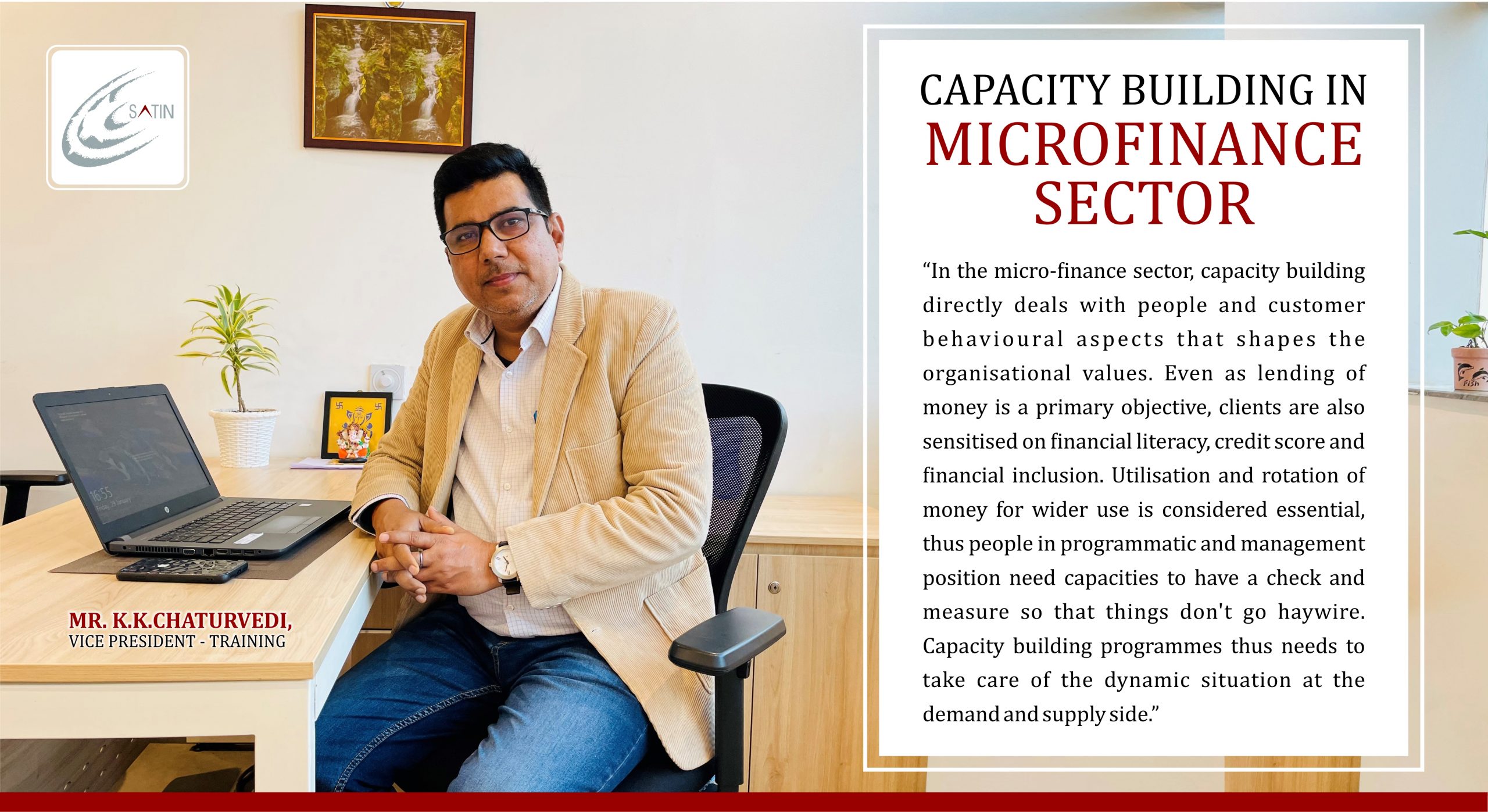
In the human development parlance, the success of an intervention is defined upon the vision, appropriate planning and programme design. The resources, especially the human resources that needs deployment, plays the most important role. But the human resources are not instant and available in the market, rather they are hired in accordance to the need and roles, and are prepared for different roles by building their capacities. Here emerges the role of capacity building. Capacity building happens to be a vast area and people need to adapt professionally as well as on inter-personal aspect so that they are not only champions of professional fulfilment but also develop rapport, partnership and long-term relationship with the beneficiaries, target groups and stakeholders at large. And, in the process they also need to improve themselves across various helms of the quantum.
In the micro-finance sector, role of capacity building is far more important, since it directly deals with people and customer behavioural aspects that shapes the organisational values. Even as lending of money is a primary objective, clients are also sensitised on financial literacy, credit score and other factors related to financial inclusion. Professionals and functionaries need a solid understanding upon monetary and human behaviours. Utilisation and rotation of money for wider use is considered essential, thus people in programmatic and management position need capacities to have a check and measure so that things don’t go haywire. They need to have certain level of sensitivity and empathy towards the communities and need to understand the given realties of the people and communities they are working with. The interventions can’t be undertaken in a robotic manner and hence the focus has to be on the behavioural change through triggering thoughts and making people realise the need for change for their own amelioration. Addressing MFI’s challenges will require investment in human resources and systems through capacity development including both training and technical assistance. Training and capacity development remains one of the biggest and at times overlooked challenges for microfinance institutions. There is a lack of regular supply of trained manpower at the grassroots as well as managerial levels.
The capacity building programmes in microfinance sector needs to take care of the dynamic situation at the demand and supply side. There are few issues in training of stakeholders which are summarised below.
Demand
In demand side, generally, very less attention is paid. The loan officer on ground are sometimes not capacitated on the nuances of the micro-financing. Only few routine trainings are planned and imparted whereas it should be based on thorough individual analysis and case to case realities. The training modules and packages need to be very comprehensive, cognitive, localised and delivery should be user friendly.
Supply
We need to take utmost care of all aspects of training of people in various roles irrespective of their position in the hierarchy. We should focus on the leadership skills, people management and developing partnerships for senior management. For the people deployed at the grassroots, we must focus a lot on their interpersonal, moderation and negotiation skills besides providing them knowledge and awareness of the business concepts and tools. We put lots of hard work in developing the learning and knowledge materials with the appropriateness of the roles and areas of operations. While imparting the training the use of technologies and ICT tools are ensured and also the trainees are made to practice on these so that they develop required level of competencies and adaptation.
Currently, not enough attention is being paid to training for senior management. This probably stems from thinking, that:
- Senior management does not really require training
- Senior management does not have the time to attend training, and
- Inadequate capacity of senior management to implement the outputs of training within MFIs
Notwithstanding the challenges cited above, we can find a way to implement capacity building by adopting technology, through following means:
- The use of technology—may have an impact on poverty alleviation and contributing to financial institutions’ bottom line
- Features that help people overcome behavioural biases by, for instance, fortifying willpower
- Digital financial services let people help each other. Digital payments for instance, by mobile phone or app can significantly strengthen people’s financial resilience by enabling an informal risk-sharing network through loans or gifts from friends and relatives
- Digital platforms have the potential to change financial services in three ways. First, they may reduce financial institutions’ imperative costs. Second, they can increase the reach of financial products, as traditional brick and mortar channels have limitations in delivering financial products to people in remote areas. And third, digital platforms can facilitate innovation in product and service design.
Conclusion
If growth and sustainability were the key concerns of microfinance industry traditionally, then good governance, client focus and networking with other development institutions are the new challenges. MFIs must gear themselves to address these new demands. We must see training as an investment rather than an expense and we have to pay more attention to training and capacity development. We have developed a very robust and comprehensive capacity building programme to offer at various levels for different stakeholders. The key activities to be focused on are improvements to corporate governance, management and information systems, lending methodologies, human resource functions, risk management and financial systems. It is not only to make our systems and interventions strong but also to support and contribute others in this space. MFIs working on similar capacity building initiatives should be willing and able to invest considerable time and energy for optimal results.
Approaches to training must be re-evaluated and made more creative. It will not be adequate to just combine classroom training with technical assistance. We must use technology to develop new methods such as e-learning to make capacity building commensurate with the growth and maturation of the industry. Only through changing our current mode of capacity building can we meet the challenges in MFIs and continue the worldwide growth of microfinance.We are innovating on it on ongoing basis and open to suggestions and partnerships for mutual benefits.
Kaushal Kishore Chaturvedi (Vice President-Training)
Satin Creditcare Network Ltd
- Date: 1st Feb’21
- Client: Mr. K.K.Chaturvedi
- Category: Blogs
